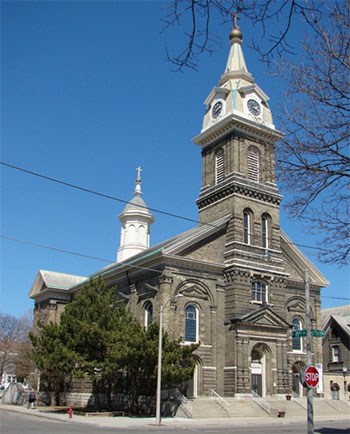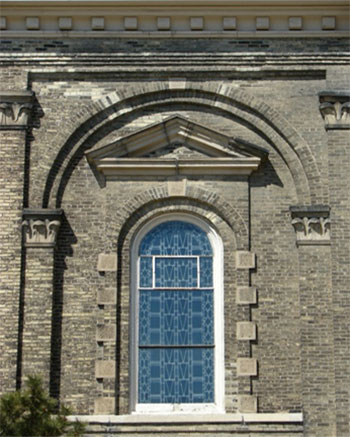5. St. Hyacinth Catholic, 1882
1414 West Becher Street
Architect: Henry Messmer
St. Hyacinth Parish, founded in 1882, is the second daughter of St. Stanislaus, following the establishment of St. Hedwig’s on the Lower East Side in the previous decade. As the Polish immigrant community on the South Side continued to grow, the archdiocese saw the need for a second Polish Catholic church in the area. The site selected for the church, about one mile southwest of St. Stanislaus, was at the southern edge of the city’s development and just two blocks north of the city limits at that time. A newspaper account of the dedication ceremony in April of 1883 noted that St. Hyacinth “is surrounded to a great extent by open prairie, the front in particular looking out on a broad, unbroken spread of rolling fields.” Today, the church is surrounded by many blocks of later housing, with the present city limits more than five miles to the south. Over the following 25 years, the boundaries of St. Hyacinth Parish were subdivided on three occasions to create the Polish-speaking daughter parishes of St. Vincent de Paul (1888), Saints Cyril and Methodius (1893), and St. Adalbert (1908). One indication of the South Side’s remarkable residential density in this period is that Saints Cyril and Methodius and St. Adalbert are each less than one-half mile from St. Hyacinth, while St. Vincent de Paul is less than three-quarters of a mile away.
The architect of St. Hyacinth Church, Henry Messmer (1839-99), was born in Switzerland and studied architecture at Heidelberg University in Germany. He also apprenticed with architects in Europe before immigrating to the United States and settling in Milwaukee in the mid-1860s. In Milwaukee, Messmer initially worked in the office of Leonard Schmidtner, who may have been the only other architect in the city at that time with training from a European university. Establishing his own office in 1873, Messmer had a varied practice that included commissions for breweries, warehouses, and other industrial buildings as well as commercial buildings and residences. In addition to St. Hyacinth, he designed two Catholic churches on the city’s East Side: St. Hedwig’s (built in 1886) and Saints Peter and Paul (built in 1890).
St. Hyacinth is a center-tower church of Cream City brick with small transepts and a large cupola above the crossing of the transepts and nave. It is the oldest remaining church in the city with a gable pediment, although the pediment is interrupted by the projecting tower. The church also has smaller pediments above the central front entrance and above most of the windows. Like St. Stanislaus Catholic and St. John’s Catholic Cathedral (with its current Renaissance Revival tower), St. Hyacinth is a more exuberant use of the classical idiom than the restrained Zopfstil designs of the older St. Mary’s and Holy Trinity Catholic churches.
Sources:
Bruce, William George. History of Milwaukee, City and County. S. J. Clarke Publishing Co., 1922.
Flower, Frank A. History of Milwaukee, Wisconsin. Western Historical Company, 1881. Facsimile reprint by the Milwaukee Genealogical Society, 1981.
“St. Hyacinth’s Dedicated,” Milwaukee Sentinel, April 2, 1883, page 3, column 1.



